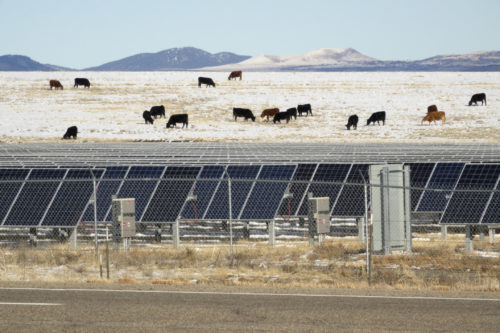
When Cheap Doesn’t Cut It: Why Energy Buyers Should Look at Value, not Just Cost
“New Record Set for World’s Cheapest Solar.” A headline like this makes for great social media fodder. The downward trend in renewables prices is fantastic—it’s the most important driver for the growth of solar and wind energy.
However, when your business or utility is comparing different energy projects, looking at cost alone is not enough. Even energy projects at very low costs can be “out of the money” if the value created by a project is less than its cost.
Choosing among Renewables Options
Rocky Mountain Institute’s Shine™ program experienced this in our work in Texas. We are helping a handful of Texas electric cooperatives (co-ops) and a university to procure distribution-scale solar power and battery storage by acting as a buyer’s representative.
For 1 megawatt (MW) projects, the top power purchase agreements (PPAs) were priced below $45 per megawatt-hour (MWh). This price is fantastic—more than 25 percent below investment firm Lazard’s $60–119/MWh estimate of prices in this segment and below the record-breaking results RMI achieved in New Mexico (when corrected for New Mexico’s stronger solar irradiation).
However, we noticed that some utility CEOs were not impressed.
“$45/MWh? I can buy wholesale power at $30/MWh in Texas.”
The problem here is that the comparison is flawed.
Sure, the $45/MWh distribution-scale solar PPA costs more than $30/MWh wholesale power. But the distribution-scale solar PPA provides more value per MWh! In addition to offsetting wholesale power, distribution-scale solar in Texas reduces transmission costs, generation amortization, and hedging costs, as we explained in a previous blog. The two different comparisons are illustrated in Figure 1.
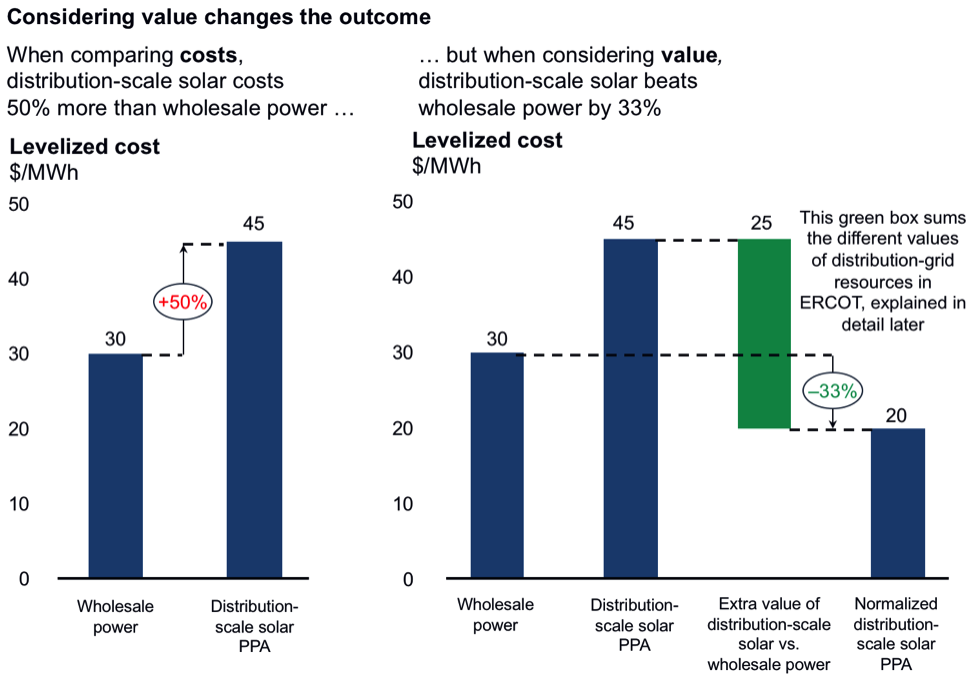
Comparing different types of energy projects (e.g., distribution-scale solar vs. wholesale power) exclusively on price is like comparing a $30,000 Toyota Sienna minivan to a $14,000 Ford Fiesta compact without acknowledging that they are different cars.
The right way to compare these two cars is to ask, “What does the costlier minivan get me that the cheaper compact car does not?” The minivan allows you to take the whole family, to use the car for moving goods, and to put your kids’ bikes in the back. These are real benefits that you’ll evaluate against the difference in costs. If you have a big family, a large car will be of good use and it will allow you to avoid additional costs, like renting a trailer. If you do not, getting a minivan will be paying for capacity that you will not use, and the Fiesta will be a better deal.
When you compare different energy solutions, you need to tally not just their costs, but also all their benefits. How did RMI do this in Texas?
Naming All Benefits
First, we created an overview of all possible benefits, listed in Table 1. We qualitatively evaluated each value category for four different types of energy projects. To make sure we did not overlook any benefits, we used RMI’s May 2017 report, A Review of Solar PV Benefit & Costs Studies. This report lists a comprehensive overview of all solar power’s possible benefits on page 13. For more information on each of the benefits, please see Appendix C of our Shine Texas Request for Proposals.
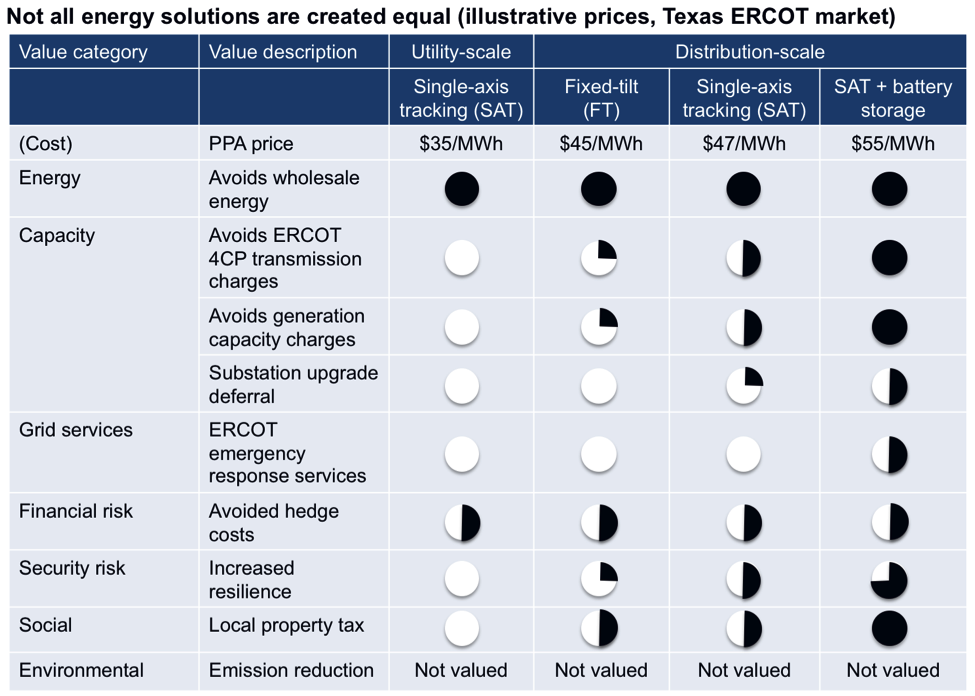
After reviewing this table, you might think, “This is a nice overview, but it doesn’t tell me which of the four energy options is best. Single-axis tracking plus battery storage has the most value, but it also has the highest cost. How do I choose the best option?”
To choose which energy option was best, we next quantified the financial value of every category.
Quantifying All Benefits
To quantify the benefits, we created a financial model that calculates the net present value (NPV) for each of the four potential energy project types listed in Table 1. Our model is publicly available here. Figure 2, from the model’s dashboard tab, shows annual cashflows by value category, with all costs in red below the x-axis, and all savings in green above the x-axis.
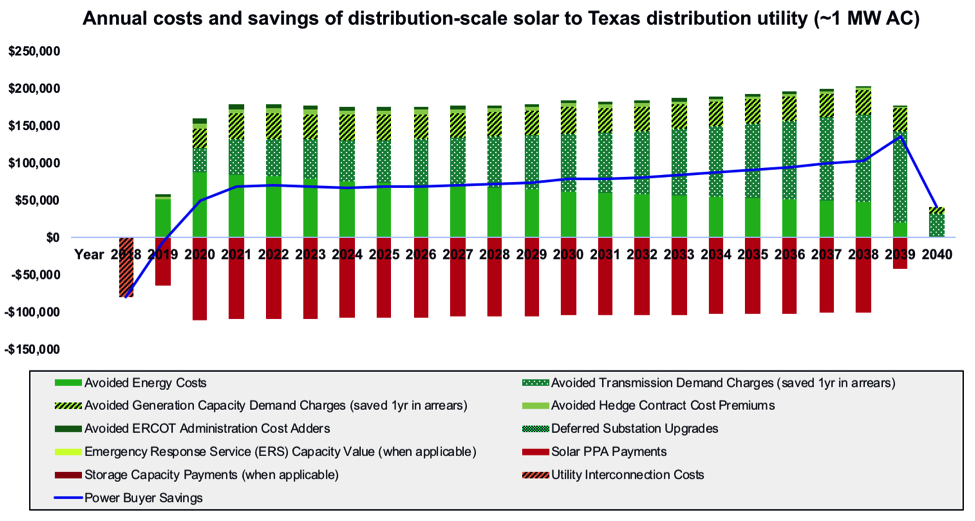
Using the cashflows in Figure 2, we calculated the present value of each value category, using the electricity buyer’s discount rate. We summed the present value of every cost and benefit to create a single monetary value for every project: the net present value.

If the Texas co-ops had chosen an energy project only on the basis of cost, they would have chosen utility-scale solar, because it has the lowest PPA price. As Table 2 shows, this would have had a 75 percent lower NPV per MW than the best option (single-axis tracking distribution-scale solar). By comparing energy projects based on net present value, these electricity buyers were able to identify the most attractive option—single-axis tracking distribution-scale solar.
Variables other than economic value could influence an electricity buyer’s decision. If a distribution utility in Texas had a need for 50 MW of new generation capacity, it might not be feasible to realize this through 50 individual 1 MW solar arrays. This could lead to a decision to purchase utility-scale solar, because economic optimization was not the primary goal.
Choosing the Top Provider for a Given Project Type
So far, we’ve shown that comparing value, not only cost, matters when you’re choosing among renewables options. It also matters when you’re choosing among providers for a single technology option.
Figure 3 shows anonymized results for half the bidders responding to the request for proposals that RMI’s Shine ran as a buyer’s representative in Texas in January 2018. The left column shows the bidders sorted by PPA price from low to high. The right column shows the NPV for corresponding bidders.

As you can see, the best five bids by PPA price are not the best five bids by NPV.
If all projects are of the same type—single-axis tracking solar PV, in this case—why doesn’t that lowest price correlate perfectly with highest value?
The difference in value is explained by when and how much electricity is produced. Solar arrays that produce electricity at the end of the day, when solar avoids transmission costs, create more value. This is why single-axis tracking solar arrays that tilt to the West at the end of the day create more value than solar arrays that permanently point South. Similarly, solar arrays that produce more electricity for the same 1 MW solar capacity create more value. Solar arrays that have more solar panel capacity for a given inverter capacity capture both these effects. This ratio is called inverter loading ratio (ILR); see Figure 4.
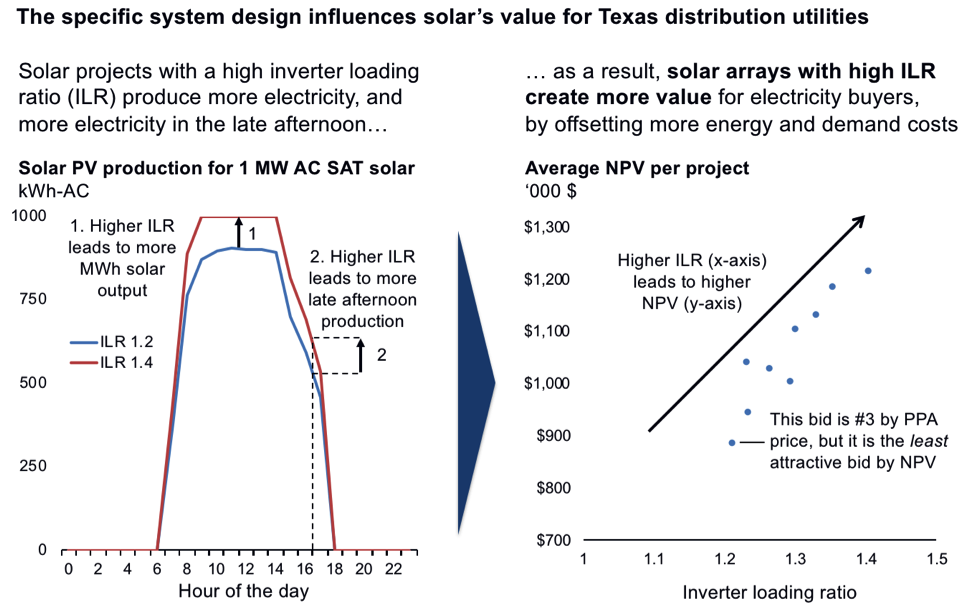
When we plot the 10 bidders in Figure 4 by net present value, we see that the top bidders were indeed those with the highest inverter loading ratio. If the Texas electricity buyers had chosen the top bidders based on cost, not value, they would not have ended up with the best possible deals. These were not necessarily the lowest-priced projects.
It’s Time for the Industry to Look at Value, not Cost
Today, most electricity buyers choose energy projects based on lowest costs. As our work in Texas demonstrates, the lowest-cost project might not be the best deal. The main takeaway? Look at value, not just cost.
Why is it typical for electricity buyers to compare energy projects on the basis of cost, not value? First, comparing exclusively on cost is simple. Second, until recently, the lowest-cost energy project closely approximated the most valuable one, because the value of electricity was roughly equal at any time of day. However, the value of electricity is becoming increasingly variable as more renewables create a dip in wholesale market prices during the afternoon and more time-of-use tariffs are implemented. As a consequence, the cheapest energy project may no longer create the most value.
Evaluating energy projects on value instead of cost can seem like a daunting task. We don’t want to make things more complicated for electricity buyers, because that would lead to inaction. With that said, most buyers are already building their own models for project evaluation, which leads to three inefficiencies: (1) everyone is “reinventing the wheel” on how to evaluate projects; (2) for each model built, there is a risk of introducing errors, which would lead to incorrect decisions; and (3) these models evaluate PPA bids from developers that have been asked to provide the lowest-cost system, which thus far has been selected based on incorrect criteria.
To make the process of project evaluation simpler, we recommend several critical activities:
- Develop a common terminology for the value of distributed energy resources and simple methodologies to calculate this value, similar to the “Levelized Avoided Cost of Electricity (LACE)” concept launched by the US Energy Information Association.
- Make resources available to explain the main value drivers of energy projects by region, type of electricity buyer, and type of project. For example, for commercial customers in California considering behind-the-meter energy solutions, energy tariffs and demand charges are the two main value drivers. For distribution utilities in Texas, transmission charges can create more than half an energy project’s value.
- Create implementation tools (such as legal frameworks, commercial contract structures, and evaluation models) that can be integrated into procurement processes and broadly adopted.
- Establish case examples where this approach creates value, identify more specifically under which conditions they are applicable, and share these examples with the solar community, much like the Texas example explained in this blog.
We anticipate that this will be an iterative process, as markets evolve and new technologies (e.g., batteries) are increasingly integrated into energy projects.
What would a future focused on value look like? If the steps above are pursued, electricity buyers could use simple metrics to assess which energy projects work best for them. Project developers would try to maximize value, rather than pitch the lowest-cost bid. Investors would assess project feasibility based on the financial value created for the electricity off-taker. And public media would focus on the millions of dollars saved on energy bills, promoting system-wide efficiency rather than asset-level cost reduction.
What do you ask the next time someone pitches you a new energy project at a competitive price?
“What’s the value?”
Are you a solar, wind, or storage project developer? We’d like to hear from you. Does our proposed focus on value make sense to you? If so, what experience do you have pitching an energy project on value, not cost? Please share your experience with us by sending an email to shine@rmi.org
Image courtesy of iStock.